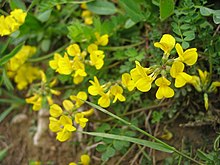Hippocrepis comosa
| Hippocrepis comosa | |
|---|---|

| |
| Scientific classification | |
| Kingdom: | Plantae |
| Clade: | Tracheophytes |
| Clade: | Angiosperms |
| Clade: | Eudicots |
| Clade: | Rosids |
| Order: | Fabales |
| Family: | Fabaceae |
| Subfamily: | Faboideae |
| Genus: | Hippocrepis |
| Species: | H. comosa
|
| Binomial name | |
| Hippocrepis comosa | |
Hippocrepis comosa, the horseshoe vetch,[1] is a species of perennial flowering plant belonging to the genus Hippocrepis in the family Fabaceae.
Description[edit]
The overall appearance depends on its habitat: sometimes it forms upright clumps of flowers; at other times, it sends prostrate leafy runners over a wide area; sometimes it distributes itself as single flowers. The flowers are small, yellow or sometimes orange/red (becoming yellow as they mature), and of typical shape for the family Fabaceae: these appear for a period of two weeks around May.[citation needed].
Propagation[edit]
The rate of seed production is variable: relatively low and sometimes negligible seed production. Seedlings remain the predominant method of extending its range. It has a low germination rate in the wild, although this can be improved in nurseries.
Distribution[edit]
Hippocrepis comosa is found in the UK, predominantly in the south.[citation needed].
Habitat[edit]
Hippocrepis comosa is a calciole (found only on chalk and limestone). It is a hardy plant that survives long periods of cold winters and dry summers years after year. Colonies are not harmed by sheep grazing, and are resistant to moderate trampling; they do not thrive after heavy ploughing or disturbance of the ground. In areas grazed by cattle they disappear, sometimes after several years (depending on grazing intensity.)
Ecology and butterflies[edit]
Hippocrepis comosa is the exclusive food plant of the caterpillars of chalkhill blue (Polyommatus coridon) and Adonis blue (Polyommatus bellargus) butterflies.[2] Populations that support such butterflies occur on longstanding ungrazed meadows, quarries, edges of paths and wasteland; outside of southern England and the Midlands (e.g. the Gower and Yorkshire populations) the climate is unsuitable for the butterflies.
Re-establishment of a colony of H. comosa is best attempted by planting individual plants: direct sowing has poor rates of success. Even this however offers no guarantee of a permanent colony (within a period as long as 20 years) and even less likelihood that the new plants will be used by significant populations of chalkhill blue butterflies within another 50 years.[citation needed]
References[edit]
- ^ BSBI List 2007 (xls). Botanical Society of Britain and Ireland. Archived from the original (xls) on 2015-06-26. Retrieved 2014-10-17.
- ^ Hippocrepis comosa
